Yesterday morning our gunky air suddenly and unexpectedly cleared out of much of the valley so I visited a local pond to see if I could scratch my photography itch on some birds that might (or might not) be there. There was sporadic excitement on the pond but much of it was too far away for decent photos so these first three images are large crops documenting behavior.
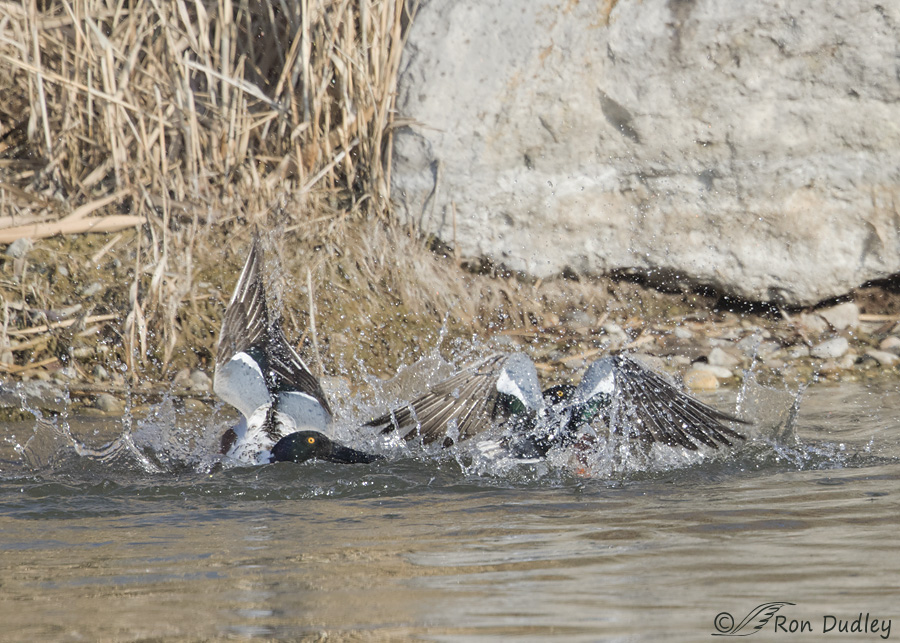 1/1250, f/6.3, ISO 500, Canon 7D Mark II, Canon EF 500mm f/4L IS II USM + EF 1.4 III Extender, not baited, set up or called in
1/1250, f/6.3, ISO 500, Canon 7D Mark II, Canon EF 500mm f/4L IS II USM + EF 1.4 III Extender, not baited, set up or called in
Based on their sporadic but epic battles, spring hormones were obviously gushing in these two male Shovelers. Serious and extended fights broke out between them at least four times in the hour or so I was there. Here I enjoy seeing the single eye peeking out between the wings of the panicked duck on the right.
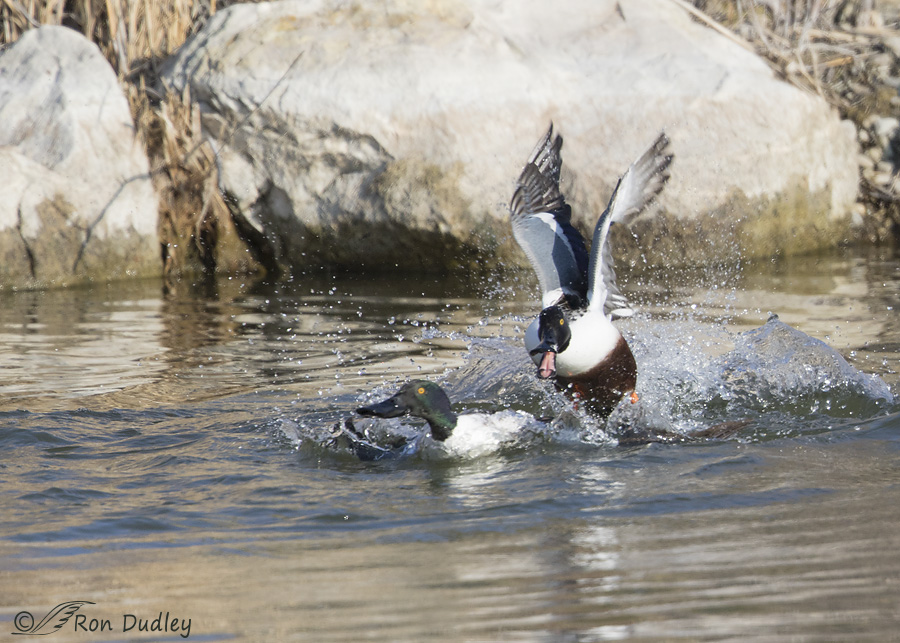
1/1650, f/6.3, ISO 500, Canon 7D Mark II, Canon EF 500mm f/4L IS II USM + EF 1.4 III Extender, not baited, set up or called in
I wish I could tell the two males apart so I knew if the same bird was always the aggressor but it appeared to me that they took turns being the bad guy. With that spatulate bill held open as it is in the duck on the right I couldn’t help thinking it might be an air drag at these speeds.
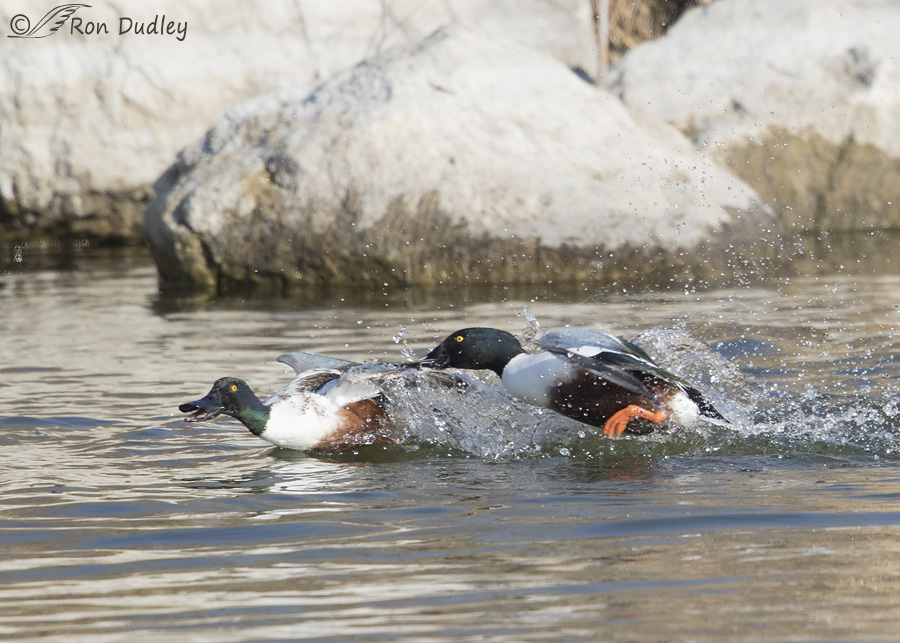
1/1250, f/6.3, ISO 500, Canon 7D Mark II, Canon EF 500mm f/4L IS II USM + EF 1.4 III Extender, not baited, set up or called in
These little ducks can really move when they want to. The two males have been on the pond for at least a week now and I can only imagine how many fights have broken out in that time.
The next image is only a progress report on one of my latest photography goals – a quality image of a Common Merganser in flight. This photo…
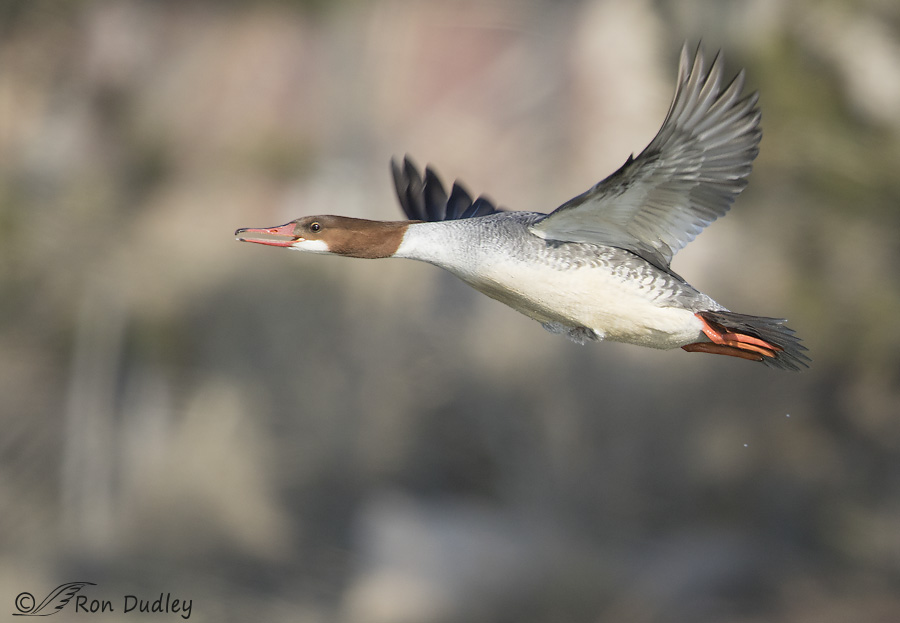 1/1600, f/6.3, ISO 500, Canon 7D Mark II, Canon EF 500mm f/4L IS II USM + EF 1.4 III Extender, not baited, set up or called in
1/1600, f/6.3, ISO 500, Canon 7D Mark II, Canon EF 500mm f/4L IS II USM + EF 1.4 III Extender, not baited, set up or called in
if far from a quality image but I’m getting closer. I was distracted when this female and some of her companions took off so I didn’t get my lens on her until it was almost too late. As a result the bird is too close to the top of the frame and not as sharp as she should be but it’s a start. Hopefully I’ll have a better image to post soon.
But most of the excitement on the pond came from a mated pair of Canada Geese. At first there were no geese on the small pond but soon several large flocks came noisily swooping in and landed quite close to me. While they were there most of them were just resting but soon the behavior of two of them changed dramatically.
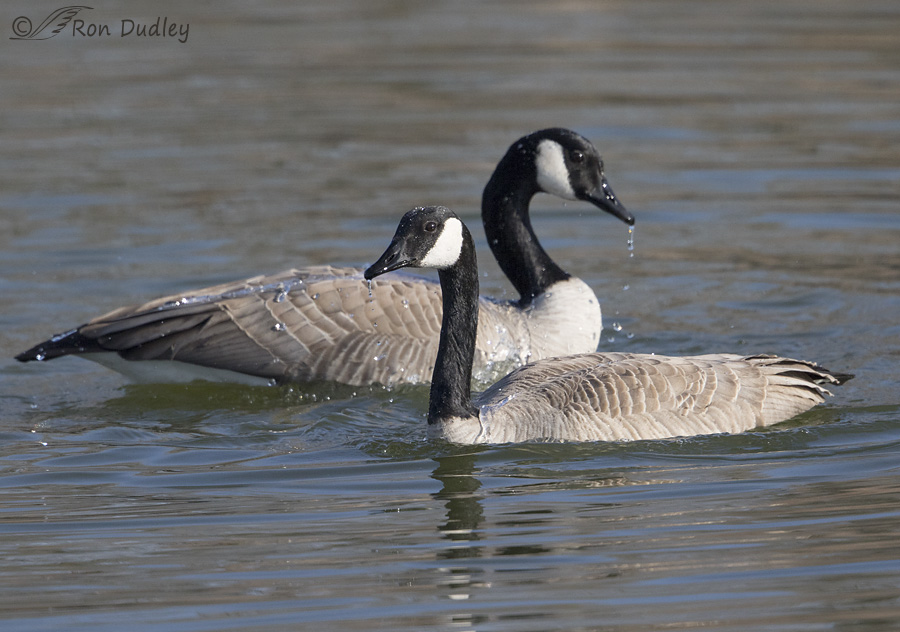
1/4000, f/6.3, ISO 800, Canon 7D Mark II, Canon EF 500mm f/4L IS II USM + EF 1.4 III Extender, not baited, set up or called in
Copulation of Canada Geese is preceded by Head-dipping and that’s exactly what this pair did for some time. They both dipped their heads and necks into the water and then raised them quickly which forces water over their backs. At first I thought they were just bathing but it soon became apparent something else was going on. I have many photos of these birds with sheets of water flowing over their backs but this is my best shot of the two of them (I was too close to them to avoid clipping body parts in many of my images).
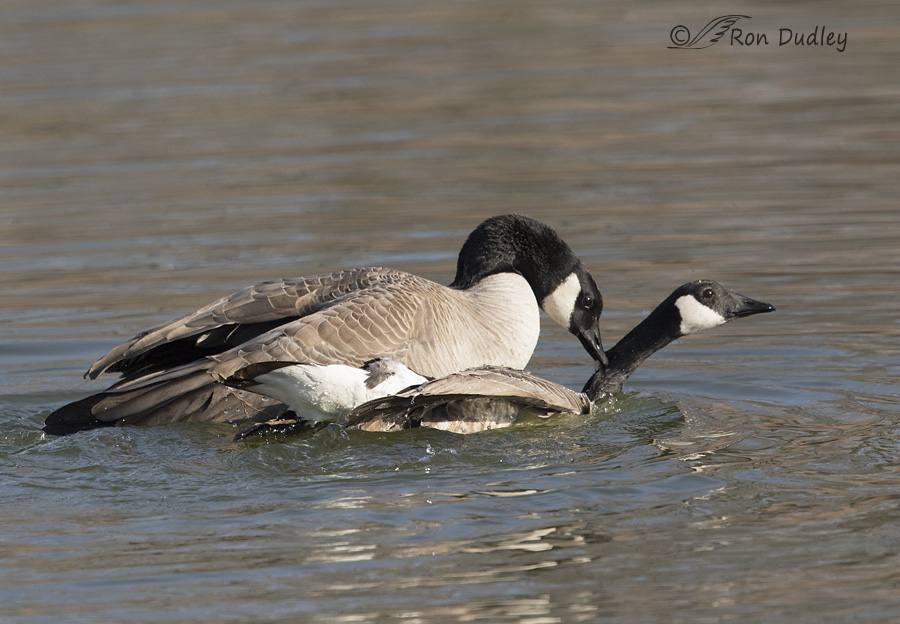
1/3200, f/7.1, ISO 800, Canon 7D Mark II, Canon EF 500mm f/4L IS II USM + EF 1.4 III Extender, not baited, set up or called in
After extended Head-dipping the male mounted the female and grasped some of her neck feathers in his bill.
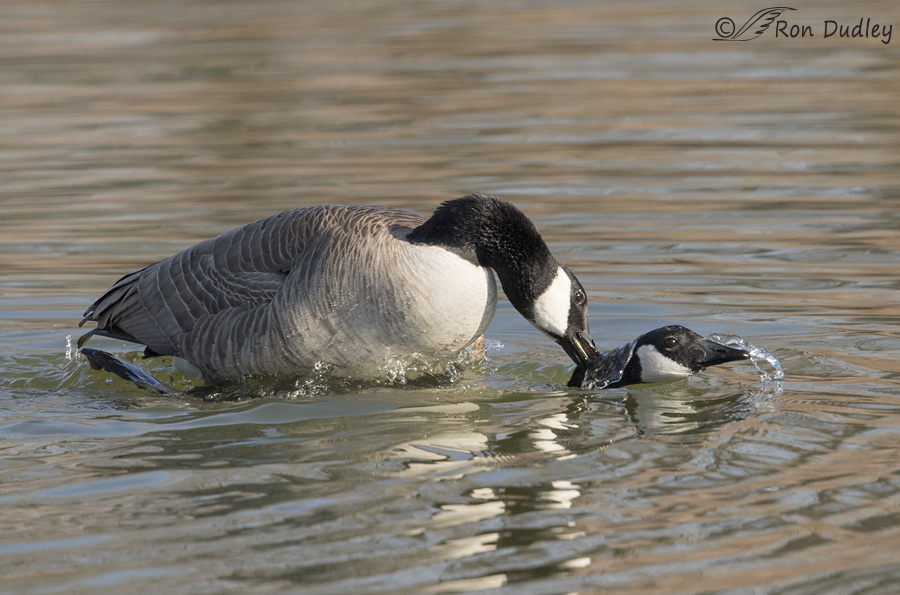
1/2000, f/7.1, ISO 800, Canon 7D Mark II, Canon EF 500mm f/4L IS II USM + EF 1.4 III Extender, not baited, set up or called in
He really had a death-grip on her. At times he even forced her head…
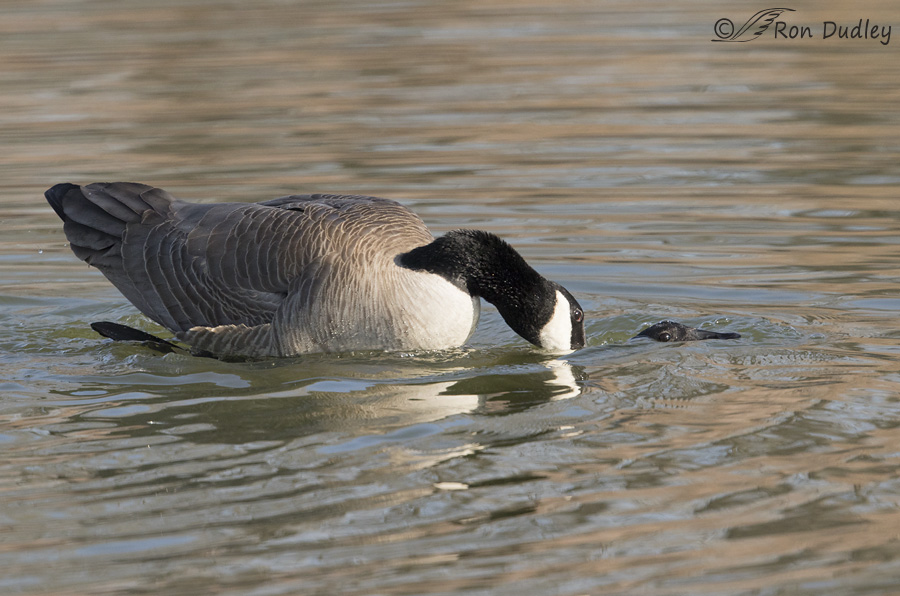
1/2000, f/7.1, ISO 800, Canon 7D Mark II, Canon EF 500mm f/4L IS II USM + EF 1.4 III Extender, not baited, set up or called in
completely underwater. I chose to post this image because we can still (barely) see her eye.
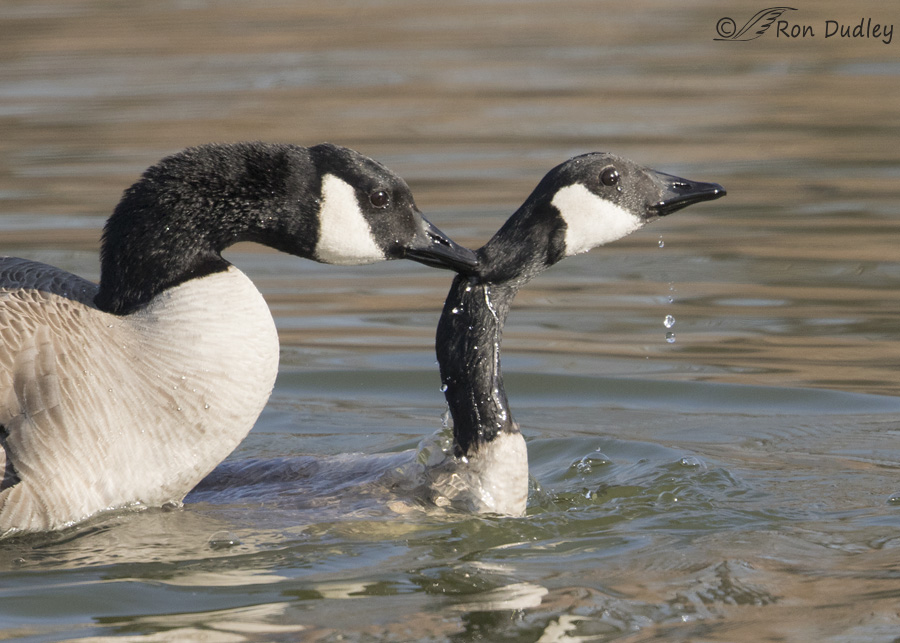
1/2000, f/7.1, ISO 800, Canon 7D Mark II, Canon EF 500mm f/4L IS II USM + EF 1.4 III Extender, not baited, set up or called in
A close crop of another image allows a more intimate look at the behavior which may appear here as forceful and violent. It really wasn’t. This is nothing like the “gang-rape mating” of Mallards where several males force a female to submit and then violently mate with her.
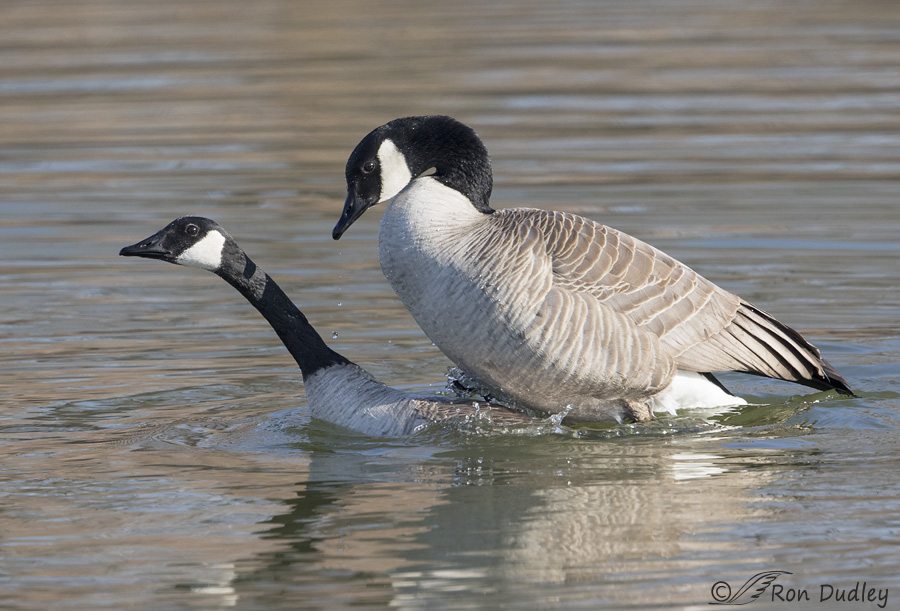
1/1600, f/7.1, ISO 800, Canon 7D Mark II, Canon EF 500mm f/4L IS II USM + EF 1.4 III Extender, not baited, set up or called in
The female was compliant and cooperative the entire time. In fact at times the male let go of her neck and just seemed to be enjoying the ride. He relaxed to the point that he even dipped his head into the water but she made no attempt to escape.
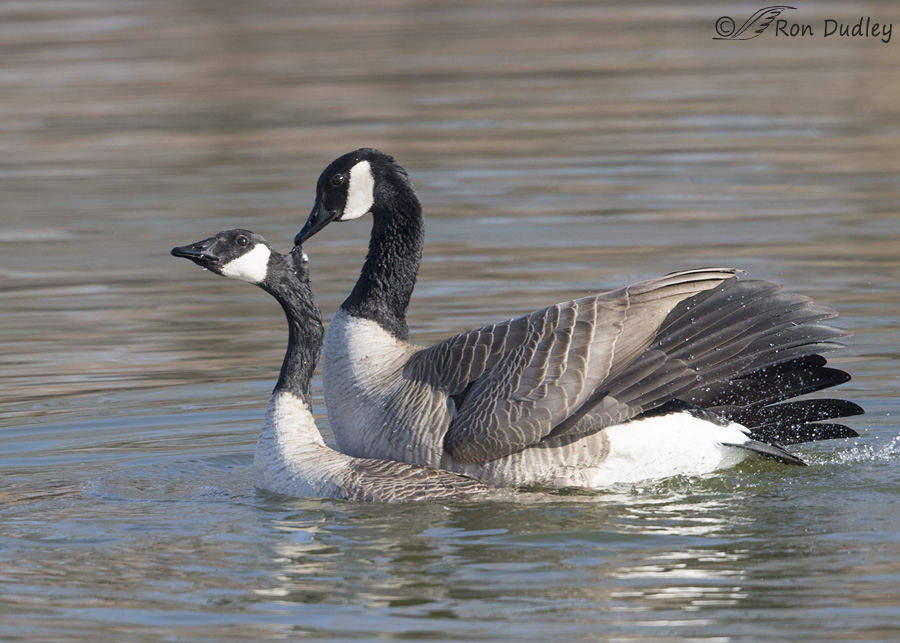
1/1600, f/7.1, ISO 800, Canon 7D Mark II, Canon EF 500mm f/4L IS II USM + EF 1.4 III Extender, not baited, set up or called in
Near the end of the behavior he pulled so hard on some of her neck feathers that…
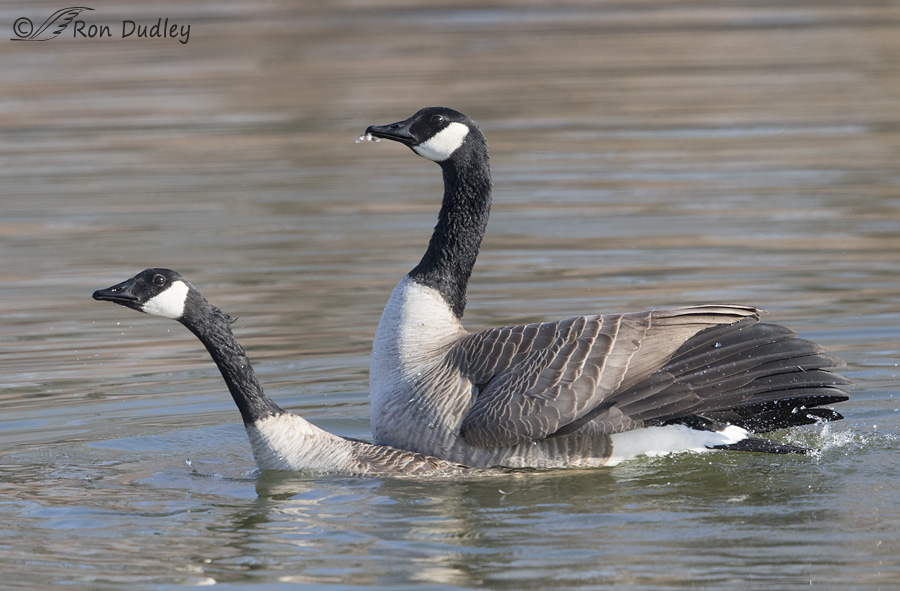
1/1600, f/7.1, ISO 800, Canon 7D Mark II, Canon EF 500mm f/4L IS II USM + EF 1.4 III Extender, not baited, set up or called in
some of them were pulled out as the female calmly swam out from under him. I’ve also seen (and photographed) neck feathers being pulled out in other mating geese in the past.
The actual maing occurred with their tails underwater so I couldn’t really tell when it happened or how long it lasted.
Canada Geese are monogamous and generally mate for life. Their divorce rate (that’s actually what it’s called) is extremely low, estimated at 1-2%. Usually, only the death of one bird of the pair will cause the survivor to seek another mate.
Humans could learn a lesson or two from Canada Geese.
Ron
Notes:
- Regular readers are aware that I nearly always shoot from my pickup but all of these photos were taken using a tripod.
- I had a brain fart this morning and in my original title (and in the email that went out to subscribers) I called the bird in the fourth photo a cormorant. Not enough coffee…



Busy place! Great series of action shots Ron!
Charlotte
I’m finally getting to your blog after midnight, so I’m blaming the steady stream of PG-13 and R-rated comments going through my head on the lateness of hour and not the dirty-ness of mind. (Either that, or I’ve taught 10th grade boys for so long that I’ve started to think like them!)
(Either that, or I’ve taught 10th grade boys for so long that I’ve started to think like them!)
These are great behavioral shots. Even though the images are clipped, I’d love to see the sheets of water flowing over the Canada Geese.
That mating is still more violent than I can cope with. And such one sided violence too. Nearly drowning and having some of my hair/feathers ripped out doesn’t do it for me. But it doesn’t have to.
I do love seeing things I will probably never see in the flesh, and learning as well. A most excellent start to my day.
I agree, it sure doesn’t look like much fun for the female, EC. It makes you wonder how those types of behaviors evolved…
Great shots Ron, and it is nice to know you are as human as we! I don’t need to add to what your readers have said, just glad you chose your words carefully!! LOL!
Dick, I’m about as human as you can get…:)
I completely agree that humans could learn a lot from Canada Geese. And I don’t have words to tell you how grateful I am to know that their mating process is not violent like Mallards. I’ve seen Mallards mating once, and it was extremely distressing. I’ve also watched the family life of Canada Geese and been very impressed. I think I’ve seen a Northern Shoveler up close only once, and found myself wondering how it kept its head above water – that beak looks very heavy. And I wish you the best in your attempts to get a Merganser in flight.
I’ve seen mating Mallards a few times too, Susan. Not a pleasant experience to watch but it seems to work for them as a species…
What Mitch said. What a delight it is to share my morning coffee with such wonderful images and behavioral insights (you know the drill. Insert the string of redundantly repetitive superlatives here). What outrageously profound and joyous gifts you share with us every morning. I’m so thankful for spending the morning with you (and everybody else here). THANK YOU so very much!
We enjoy having you here, Laura. Thank you.
Great series of photos Just one correction. Not exactly a “cloacal kiss” in this case since Ganders have a Penis.
Just one correction. Not exactly a “cloacal kiss” in this case since Ganders have a Penis.
You’re absolutely right, Leah. I knew that too. Two screw-ups in one post – sheesh! Thanks for the heads up. I’ll edit my text.
I was going to edit your text, too, but I got distracted and that didn’t happen. Sigh…IF I had a brain, I’m sure I’d be dangerous. Alas, I don’t so I’m not. That might be a good thing
Hi Ron,
I love your line, “In fact at times the male … just seemed to be enjoying the ride.” No comment. Several come to mind, but I suspect they might not get by your censor…
Cheers,
Dick
I chose those words carefully, Dick…
I would hope the lesson to be learned from Canada geese wouldn’t include near drowning of females! Mallards are brutal!!! Merganzer may not meet your standards, but I like it very much, including the placement in the frame, which implies altitude…
Interesting that you like the placement of the merganser in that shot, Patty. Given your artistic background I may have to reconsider my original thought about that.
Ha ha ha ha !!! Pulled a Marina!! Love pictures !! Geese are thicker than flies this year never saw so many…. going to have to go to ponds didn’t realize waterfowl were mating already wow!! Been to busy chasing goldens totally obsessed with getting that perfect golden picture which keeps eluding me inspire of lots of opportunities… so it’s nice to see some good pictures in am before looking at mine
Thanks, Marina. I was a little surprised at how early these geese were mating too.
What fun! You really captured the behaviors of these water fowl I hadn’t previously noted on water fowl that the upper beak does have a bit of a hook at the tip.
I hadn’t previously noted on water fowl that the upper beak does have a bit of a hook at the tip.
He used that hook pretty effectively on her neck, Judy.
Ron:
“Ducks Fighting, Mergansers Flying and Geese Mating,” what a great name for your next book!
Thanks for the lessons on bird behavior. The Stokes would love it. I certainly enjoyed your blog today. Thank you.
Richard, My next book would be my first book if it ever happened. But it won’t because I just don’t have enough time. Thanks for the confidence though…
This is why I hit your site each morning with my first cup of coffee in hand; to not only view fine imagery, but to get a firsthand documentation of what your camera captured. The imagery stands by itself, but coupled with your observations that are both analytical and grounded in real world experience, my daily visits have turned into a treat. Tip o’ the cap, here. Thanks, again, Ron. Best….Mitch
I’m delighted to know you enjoy your visits here so much, Mitch. Thanks very much for that feedback.